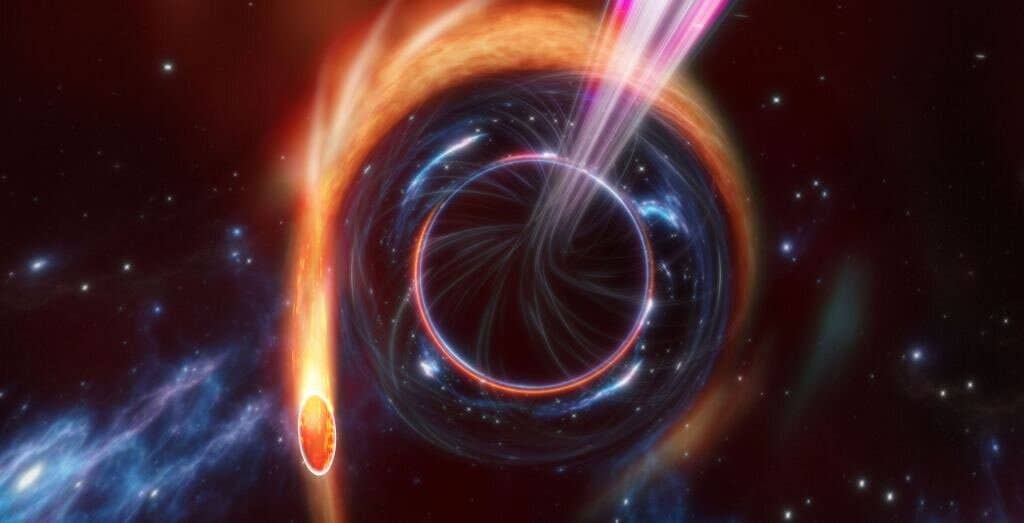Groundbreaking discovery challenges our understanding of gravity, light and the universe
Researchers have made a groundbreaking discovery that may change our understanding of gravity, light and the universe as we know it.

[May 4, 2023: Staff Writer, The Brighter Side of News]
A star is being consumed by a distant supermassive black hole. Astronomers call this a tidal disruption event (TDE). As the black hole rips apart the star, two jets of material moving with almost the speed of light are launched in opposite directions. One of the jets was aimed directly at Earth. (CREDIT: Carl Knox)
Researchers have made a groundbreaking discovery that may change our understanding of the universe as we know it. In the exotic conditions of the early universe, waves of gravity may have shaken space-time so hard that they spontaneously created radiation. This result gives rise to an entirely new phenomenon: the production of light from gravity alone.
The research was conducted by a team of scientists from the Université Paris-Saclay and the French National Center for Scientific Research. They focused on the concept of resonance, a phenomenon that occurs when a system is subjected to a periodic force whose frequency is close to the natural frequency of the system. In this case, the system was the early universe and the periodic force was the gravitational waves that were generated during the inflationary period.
Inflation is a hypothetical event that occurred when the universe was less than a second old. During this period, the universe expanded at an incredible rate, becoming many orders of magnitude larger than it was before. At the end of inflation, the universe was filled with gravitational waves that sloshed back and forth throughout the cosmos.
Gravitational waves are waves of gravity that are generated when massive objects accelerate. They were first predicted by Albert Einstein in 1916 as a consequence of his theory of general relativity. However, they were not directly detected until 2015, when the Laser Interferometer Gravitational-Wave Observatory (LIGO) detected the merger of two black holes.
Related Stories
Normally, gravitational waves are extremely weak. We have to build detectors that are capable of measuring distances less than the width of an atomic nucleus to find gravitational waves passing through the Earth. But the researchers have pointed out that in the extremely early universe, these gravitational waves may have become very strong.
According to the researchers, the strong gravitational waves may have created standing wave patterns where the waves were not traveling but stood still, almost frozen in place throughout the cosmos. Since gravitational waves are waves of gravity, the places where the waves are the strongest represent an exceptional amount of gravitational energy.
The researchers found that this could have major consequences for the electromagnetic field existing in the early universe at that time. The regions of intense gravity may have excited the electromagnetic field enough to release some of its energy in the form of radiation, creating light.
The exponential instability of ay and az in the vacuum where cs=1. (CREDIT: ScienceDirect)
"This result gives rise to an entirely new phenomenon: the production of light from gravity alone," said Richard Holman, a physicist at Carnegie Mellon University in Pittsburgh, who was not involved in the research. "There's no situation in the present-day universe that could allow this process to happen, but the researchers have shown that the early universe was a far stranger place than we could possibly imagine."
The discovery of the production of light from gravity alone has important implications for our understanding of the early universe. It suggests that the universe was a much more complex and dynamic place than we had previously thought. It also raises the possibility of new discoveries in the future, as researchers continue to explore the early universe and the laws of physics that govern it.
The research has been published in the journal Physical Review Letters. The team of researchers was led by Dr. Fabio Finelli from the Université Paris-Saclay and the French National Center for Scientific Research. They used advanced mathematical techniques to model the behavior of the electromagnetic field in the presence of strong gravitational waves.
"Our work shows that the production of light from gravity is not just a theoretical possibility, but it actually happened in the early universe," said Dr. Finelli. "This is a major discovery that could have far-reaching implications for our understanding of the universe and the laws of physics that govern it."
The discovery of the production of light from gravity has been met with excitement from the scientific community. It is seen as a major breakthrough that could open up new avenues of research and lead to new discoveries in the future.
The discovery also has important implications for our understanding of the early universe. It suggests that the universe was a much more complex and dynamic place than scientists had previously thought. It also raised questions about the nature of gravity itself. Gravity is one of the four fundamental forces of nature, but it is the weakest of the four.
The discovery of the production of light from gravity alone suggests that gravity may be more powerful than we had previously thought.
For more science and technology stories check out our New Discoveries section at The Brighter Side of News.
Note: Materials provided above by The Brighter Side of News. Content may be edited for style and length.
Like these kind of feel good stories? Get the Brighter Side of News' newsletter.



